Lake Eyre Basin 2012 Ministers` Report to the Community
advertisement
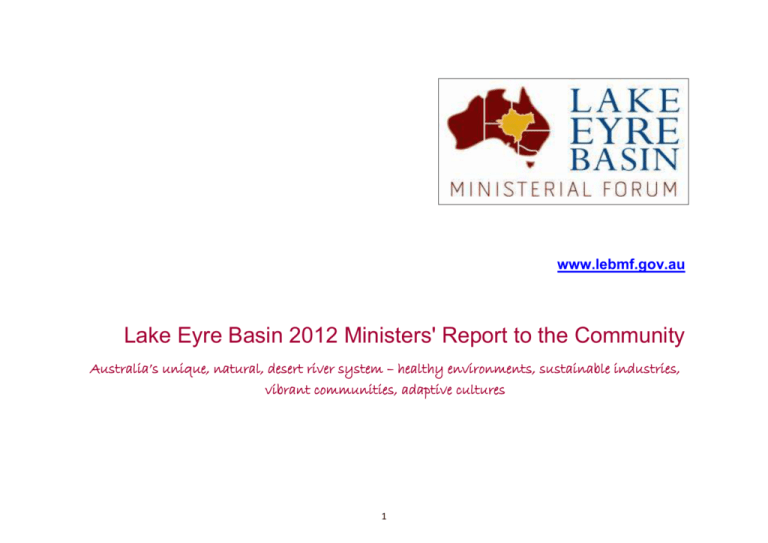
www.lebmf.gov.au Lake Eyre Basin 2012 Ministers' Report to the Community Australia’s unique, natural, desert river system – healthy environments, sustainable industries, vibrant communities, adaptive cultures 1 2 3 Message from the Ministers Under the Lake Eyre Basin (LEB) Intergovernmental Agreement, the Australian, Queensland, South Australian and Northern Territory governments are working together to protect and manage the Lake Eyre Basin’s water and related natural resources. Progressing partnerships to better manage the Lake Eyre Basin Since our last message to you, much has occurred to strengthen our collaborative approach to managing the LEB sustainably. We are pleased to report good progress in implementing the Five Year Action Plan in partnership with our stakeholders. For the LEB Rivers Assessment -our long-term program to assess the condition of the Basin’s watercourses and catchments – our governments, science organisations and community members are collaborating to: second year of on-ground monitoring at key water sites around the Basin; establish a Consortium of research institutions, regional organisations, nongovernment bodies and industry players to guide the Rivers Assessment program under a shared investment model; engage Basin land managers and decision makers in Strategic Adaptive Management (SAM), to work towards agreed future monitoring under a shared vision for the condition of the Basin’s catchments and Halligan Bay, Lake Eyre North, Matthew Turner watercourses; further our knowledge of trends in waterbird abundance and invasive species management; and undertake a regional trial of the SAM approach to help us expand it across the Basin. Ensuring a healthy future for LEB watercourses and catchments requires us, as a whole community, to be aware of likely trends in climate, population movement and industry development and of consequent pressures and opportunities. To this end, we are continuing the conversation with our stakeholders about likely Basin futures, which began at the 2010 LEB Biennial Conference and continued with the December 2011 LEB Foresighting Workshop. In conjunction with SAM, this will underpin our ability to better manage and respond to potential changes affecting the Basin’s water and related natural resources in future. An important element of the Rivers Assessment, indeed of all programs under the LEB Agreement, is participation of Aboriginal people. A fourth, successful LEB Aboriginal Forum was held in Tibooburra NSW last year. These events, held since 2004, are a cornerstone in our long-term relationship 4 with Aboriginal people of the Basin, and we look forward to continuing participation of Aboriginal people in all that we do. We are confident that these and other efforts to progress positive partnerships with LEB land managers and residents, industry players, the science community and conservation groups provide a sound basis for working together in the future. Australian Government Minister for Sustainability, Environment, Water, Population and Communities, the Hon. Tony Burke MP (Chair) Queensland Minister for Natural Resources and Mines, the Hon. Andrew Cripps MP South Australian Minister for Sustainability, Environment and Conservation, the Hon. Paul Caica MP Chief Minister and Minister for Land Resource Management, The Hon Terry Mills MLA From the Chairs Chair of the Community Advisory Committee - Angus Emmott Last year’s rainfall and floods in the Lake Eyre Basin (LEB) generated widespread productivity, but also a big fire season for many landholders and communities. An unexpected fourth consecutive flood year has brought relief, together with another boom season for ecosystems and pastoral industries in the Basin. Growth in mining and petroleum exploration continues in the Basin, including for unconventional gas. There is concern from stakeholders in the Basin regarding how we might manage the potential negative impacts of such a fast growing sector on our environment, local industries and communities, while ensuring benefits to all. These industries are key players in the Basin’s future and will be important partners in the Strategic Adaptive Management (SAM) framework. Funding for the SAM process remains a challenge and contributions generated directly from the mineral and petroleum wealth of the Basin will be highly desirable to materially support its long-term implementation. Aboriginal participation in the LEB Agreement remains strong with the fourth LEB Aboriginal Forum in Tibooburra, NSW, the LEB Aboriginal Map project, and Aboriginal participation in LEB Rivers Assessment monitoring. I would like to particularly thank the six Aboriginal LEB Community Advisory Committee members for their continued energy, good humour and commitment to building strong Aboriginal foundations into our work. The Queensland Government’s Wild River declarations for the Queensland LEB catchments and the establishment of the Queensland LEB Wild River Ranger Program have been major initiatives for the Basin, and especially positive for Aboriginal people of western Queensland. The sad loss in 2011 of ABC journalist and author, Paul Lockyer, photographer John Bean and pilot Gary Ticehurst, was felt by many across the Basin. Paul Lockyer’s wonderful recent book ‘Lake Eyre – a Journey through the Heart of the Continent’ celebrates our amazing part of the world and the great contribution made by these three men to its unfolding story. The LEB is internationally important and I believe the cooperation and good will among the community and industry members, scientists and government staff involved in the LEB Agreement is also unique. Working with such people for the sustainable future of the Basin is a privilege. I especially look forward to working with the incoming Chair of the LEB Scientific Advisory Panel, Dr Steve Morton, following his return after an absence of several years. Chair of the Scientific Advisory Panel Steve Morton It is delightful to be able to note yet another big flood year in the LEB. This sustained period of growth and re-charge is of substantial ecological and human importance because it enables both the human and ecological communities to build resilience in readiness for the next big dry, noting of course the undoubted short-term disruptions from flooding. In the case of the Scientific Advisory Panel (SAP) the wet period also provides breathing space for better establishment of the major initiative underway, which is implementation of the LEB Rivers Assessment (LEBRA). We are, additionally, preparing to trial the SAM approach for the ongoing refinement of the LEBRA through real-life application. The trial site aims to include a range of interests, issues and objectives together with a complexity of decision pathways, via identification of ‘thresholds of potential concern’. The SAM approach was adopted by the LEB Ministerial Forum two years ago. Like many communities in regional Australia, people of the LEB are expressing strong interest in developments with petroleum (in particular, coal 5 seam gas) and minerals exploration. In collaboration with the Community Advisory Committee, the SAP is maintaining a keen interest in these matters and is planning for incorporation of related hydrological and ecological issues into the LEBRA in an effort to help guide socially-accepted development of the industry. Simultaneously, the SAP continues to advocate for adequate resourcing of the LEBRA program into the future while, more broadly, working with the LEB community to overcome funding constraints that currently limit the full potential of the LEB Five-Year Action Plan. Four new SAP members, including the Chair, have been appointed by the Ministerial Forum for a period of three years: Dr Steve Morton (Chair), Professor Angela Arthington, Dr Sue Jackson and Professor Keith Walker. Three existing members were also reappointed for a period of a further three years: Professor Richard Kingsford, Dr Tara Martin and Dr Bill Young. I thank the Chair of the Community Advisory Committee, Angus Emmott, for his knowledge, counsel and guidance as I settle into my new role. Horseshoe Bend, Finke River NT, Chris Brown (NT Govt) Lake Eyre Basin Five -Year Action Plan Now in its third year of implementation, we report on some key achievements and progress under the Lake Eyre Basin Intergovernmental Agreement Five-Year Action Plan 2009 - 2014 (the Plan). Visit the LEB Ministerial Forum website to view and download the Plan: http://www.lebmf.gov.au/publications/pubs/lebfive-year-action-plan.pdf Lake Eyre Basin Rivers Assessment Understanding whether the Basin’s catchments, river channels, flood plains, waterholes and lakes are healthy and functioning well, is essential information for everyone in the LEB community who wishes to manage the Basin’s natural resources sustainably. Also important to land use decision makers, is understanding how the health of the Native fish caught during LEBRA monitoring, Dale McNeil Basin’s watercourses and catchments can be impacted by factors like water resource developments and changes in land use. The Lake Eyre Basin Rivers Assessment, or LEBRA, began to build this body of knowledge in a collaborative and integrated way in 2011 with the commencement of an annual monitoring program. Scientists from Qld, the NT and SA began the collection of data about hydrology, water quality and fish at fifty-seven sites across the Basin. The program is providing an opportunity to collect data in some areas never before surveyed and has made a number of significant findings, such as finding fish species in new areas for the first time. At some monitoring sites, land managers, including pastoralists and Indigenous Rangers, had the opportunity to work with visiting scientists to collect the data, find out more about their local waterholes and share their knowledge of these water places with the monitoring team. One Indigenous Ranger had this to say about his involvement in the LEBRA monitoring work... “This is an opportunity for us to learn skills from the scientists and maybe one day we (Tjuwanpa Ranger Group) could do the monitoring ourselves. We have learnt about species that we didn’t know much about before Pulling up fyke net at Algebuckina Waterhole SA, Dale McNeil 6 because the scientists bring out lots of equipment to catch animals, like big nets. On the other side, the scientists are learning about what fish and water mean to us, and we can talk about how our people use these species. Hermannsburg people are one of the few communities who have fish close by, in the Finke River, so we know a lot about these species, especially the ones that are good to eat!” Damien Williams, Tjuwanpa Indigenous Ranger, Hermannsburg NT A detailed report on the findings of the 2011 LEBRA will be available in mid 2012. The 2012 monitoring program commenced at waterholes in the Finke River catchment in the NT, once again in collaboration with the Tjuwanpa Indigenous Rangers. With funding through the LEB Ministerial Forum and from other key LEB partners, the LEBRA program will return to these water places annually, to monitor their condition and build, with every year, our understanding of the health of the Basin’s catchments and vast network of watercourses. Work is also underway to enhance the program through the development of a LEBRA Consortium, Indigenous Ranger measuring fish length, Dale McNeil 2012 to bring together the best expertise and capability from a range of organisations and institutions. A collaborative approach among these expert groups will be the most effective way to implement a monitoring and assessment program on the scale of LEBRA. The Consortium would also continue to implement LEBRA within a Strategic Adaptive Management framework. In early 2012, the Australian Government’s ‘National Environmental Research Program’ provided funding to support the implementation of LEBRA and the development of the Consortium, boosting existing inputs from the four signatory governments to the LEB Intergovernmental Agreement. Shared vision, learning and action Strategic Adaptive Management Building a collective vision among all players in the LEB community whose activities have the potential to affect the health of the Basin’s catchments and watercourses is the central plank of a process called Strategic Adaptive Management, or SAM, now adopted by the LEB Ministerial Forum as the framework for the LEBRA program. The SAM framework provides a way of focusing LEBRA science onto the real challenges which may affect our shared vision for a healthy Basin, and provides a way for Basin land users to connect the LEBRA scientific knowledge base with their decision-making. It is a ‘learning by doing’ approach that is based on key stakeholders, whose management decisions could affect the health of the Basin, being involved in six key steps: Negotiating a collective vision for the desired condition of the Basin; Identifying potential changes that may jeopardise that desired future; Setting and monitoring indicators that will alert the community to changes in the health of the Basin; Identifying what management is required to respond to these changes; Implementing management decisions; and Evaluating and learning, as a community, from the outcomes. Workshops held during 2010 and 2011 involving key stakeholders such as the LEB Community Advisory Committee, the LEB Scientific Advisory Panel, government members and NRM Board representatives, have begun to develop and promote an understanding of how SAM can work in the Lake Eyre Basin. A planned regional trial of the SAM approach, commencing in 2012, seeks to demonstrate its practical application on a manageable scale. The SAM framework will help ensure that the LEBRA is useful and effective by anchoring its implementation to the people, organisations and institutions responsible for making decisions that will affect the rivers and catchments of the Basin. SAM will take time and commitment to work and is an ongoing and iterative process. For key LEB stakeholders, the SAM approach to the LEBRA is an opportunity to: Sign at Eromanga, Angus Emmott be part of a collaborative conversation among players, based on open sharing and interpretation of data and information, and on collective decisions about natural resource management responses; work with change agents who may be currently outside their circle of influence, but whose actions and decisions nevertheless affect them. Stakeholders who want to be part of this collective approach to securing a healthy future for the Basin can contact the LEB Secretariat in Canberra for more information on (02) 6274 2803. LEB Foresighting Workshop What forces will make the most difference in shaping the LEB future? What changes will pose the greatest challenges to the water and related natural resources of the Basin? Action eight of the LEB Five-Year Action Plan is to carry out sectoral and Basin-wide foresighting 7 studies to explore how the use and management of the LEB’s natural resources might evolve in the coming twenty-five years, and how we might respond to these changes. Hand in hand with this, Strategic Adaptive Management for the LEB Rivers Assessment requires us to consider what future changes in the LEB riverine landscapes may jeopardise our collective, desired future for the Basin, what thresholds in these changes would cause us concern, and what indicators need to be monitored to detect when these thresholds are being approached. The 5th LEB Biennial Conference in 2010, themed ‘The Future of the Lake Eyre Basin’, raised challenging questions and highlighted major forces with potentially significant future impacts on the Basin, both positive and negative. These included a sustained growth in mining and petroleum exploration and development, increasing tourism, a continuing and potentially greener pastoral industry, along with climate change and a low carbon future. The first LEB Foresighting Workshop, held in Adelaide in December 2011, took these and other emerging forces and considered how they might intersect with each other. What if an expanded mining and petroleum industry coincided with a 4WD touring across Simpson Desert in full bloom, Matthew Turner Petroleum well near Cooper Creek, Joc Schmiechen massive tourism boom, or with runaway climate change? What desirable or undesirable scenarios could we anticipate if these forces were to coincide? What knowledge and what action would be needed to prepare ourselves for this? economies. And are we directing our attention to what could The LEB Five-Year Action Plan (the Plan) have the most impact on the things we value in the recognises the importance of tourism to the local Basin? The workshop generated a wealth of such economies of the Basin and the benefits of tourism possible scenarios, together with a rich variety of as a vehicle for improving awareness of the natural, potential actions and knowledge to prepare for them. cultural and historical values of the Basin. The Plan In the coming months, key themes, preferred futures also acknowledges the potentially damaging impacts and important warning signs from this material will that tourist activity can have on the natural and be distilled and shared with the broader LEB cultural values of the Basin, particularly on the more community. sensitive natural assets of the Basin, such as permanent waterholes. Building on processes and Tourism in the Lake Eyre Basin programs already in place that seek to minimise Our continuing fascination with the remote outback potential tourist damage to the LEB landscape, the landscapes and communities of the Lake Eyre Basin Ministerial Forum has agreed to develop an has, for a fourth consecutive year, attracted Information Sheet on water and related natural increasing numbers of resource values of the LEB and the threats tourism Australian and might pose to those values. The Information Sheet international travellers to may be a useful means of engaging key tourism and the region, keen to natural resource management stakeholders in experience the outback at developing options for collaborative monitoring and its glorious best – mitigation of tourist pressures that threaten the booming with water and Basin’s key values, particularly those on which the wildlife. Despite the LEB Intergovernmental Agreement is built. challenges of drenching Sites under particular pressure from intense tourist rainfall, limited activity may also be targeted by the LEB Rivers infrastructure and Assessment, making it possible in the future for land floodwaters, steady managers to understand any potential links between visitation to the region river or catchment condition and tourism activity, has been welcomed by and through the SAM process, identify what might tourism industry groups be done to best manage these impacts. and operators and provided an important seasonal boost to local 8 4th Lake Eyre Basin Aboriginal Forum, Tibooburra NSW, September 2011 In 2004, the first Lake Eyre Basin Aboriginal Forum was held in the Northern Territory at Hamilton Downs Station, near Alice Springs. The event brought together a small, but enthusiastic, group of Aboriginal people from around the LEB to talk about land and water management, and ways that Aboriginal people could better participate in the implementation of the Lake Eyre Basin Intergovernmental Agreement (the Agreement). Since then, Aboriginal Forums have been held at Mount Serle Station (SA) in 2006, in Birdsville (QLD) in 2009, and most recently in September 2011 in the ‘corner country’ town of Tibooburra (NSW). Nearly eighty Aboriginal and non-Aboriginal people came to this south-eastern corner of the LEB, to reflect on the progress of Aboriginal participation under the Agreement, to re-establish and build new connections, and to share knowledge and visions for the future of the LEB. “I felt privileged to meet new people from across the Basin. For my group I gained an understanding of some of the issues facing the Basin.” (Forum participant) With the theme of ‘Water, land and connections across the Lake Eyre Basin -sharing the journey and passing on knowledge’, the 2011 Aboriginal Forum created a respectful and comfortable space where Aboriginal people could reconnect and share stories and knowledge with people from other parts of the Basin, and together, develop shared goals for protecting the Basin’s water, land and cultural resources. Forum participants shared personal stories of country and of tragic experiences during the early Participants at the LEB 2011 Aboriginal Forum in Tibooburra NSW, Matthew Turner period of white settlement; they exchanged traditional and western knowledge of water and land management; told inspirational stories of achieving their dreams as traditional people in a contemporary world; and shared experiences about on-ground, knowledge recording and research projects that are getting people back to country to enhance and protect the traditional knowledge, spiritual significance and health of important water places. “Have had an excellent opportunity to network, learn more about the LEB and people involved...meeting new people, very informative, excellent.” (Forum participant) Forum participants also made a substantial contribution to the LEB Aboriginal Map project, drawing on their vast knowledge and experience to provide input and feedback on the draft content for the map. By the conclusion of the Forum, participants had collectively framed some clear directions and recommendations around six key areas: Science and management projects carried out in the LEB; Extractive industries and groundwater (especially coal seam gas); Traditional ecological knowledge; A National Centre for Aboriginal Water Research; Sustaining the effort through a cultural water and land management plan, under an LEB Authority; and Declaration of Wild Rivers in the Queensland LEB. A summary of outcomes from the LEB 2011 Aboriginal Forum is available at www.lebmf.gov.au - Conferences and Forums. For more information about the 2011 Aboriginal Forum, or future events, contact the LEB Facilitator Vol Norris, vol.norris@environment.gov.au, (07) 4650 1235. 9 LEB Aboriginal Map and Booklet Work has continued over the last year on production of the Lake Eyre Basin Aboriginal Map (poster) and Booklet. This much anticipated resource will provide a pictorial overview of the presence and significance of Aboriginal people in the Basin, highlighting the richness, diversity and vibrancy of Aboriginal culture which remains strong across this vast arid landscape. michelle.rodrigo@nt.gov.au. Adnyamathanha petroglyphs, Mt Chambers Gorge, Flinders Ranges SA – Joc Schmiechen The poster will be the first of its kind to present multiple layers of information about the enduring connection between Aboriginal people and the LEB landscape, with a particular emphasis on the importance of water and land resources to Aboriginal culture and survival. Acknowledging the limitations of this endeavour, the poster and booklet will provide just a taste of the rich and complex stories and knowledge shared so generously by Aboriginal people from all corners of the Basin. The project has worked with Aboriginal people from across the Basin, building layers of information to communicate to all people, within and outside the Basin community. The messages about culture and looking after country are strong, inspiring and passionate. They collectively paint a picture of life for Aboriginal people in the Basin before and after white settlement, and of what is important to people who nowadays live, work, raise their families and remain spiritually connected to the Lake Eyre Basin. Lily Lagoon, Longreach Qld – Angus Emmott With still more work to do in consultation with Aboriginal people, groups and organisations across the Basin, production continues to inch steadily towards completion in 2012. The project is financially supported by the LEB Ministerial Forum and participating governments, with generous contributions from regional NRM groups, SANTOS and BHP Billiton. For more information about this exciting project, or to register your interest in obtaining a copy of the publication, contact Michelle Rodrigo, LEB Communications Officer, (08) 8951 9255, 10 Bustard tracks in the Simpson Desert – Angus Emmott Parallel dunes and green swales of the Simpson Desert after rains, Jason Barnetson People of the Basin family connections. Living on country and looking after it is great because a big part of our job is looking after our homelands and it’s really good to hear the Community say that we’re doing a really good job…it makes it all worthwhile.” Damien Williams, Tjuwanpa Indigenous Ranger, living at Hermannsburg, NT “Our country has been pretty green and there’s been lots of water about. It’s unusual to have such a long wet period. The Finke has been flowing since 2010; it’s slowed to a trickle now, but is still flowing, and that’s pretty weird for out here. The country is going back to how it was in the old days. We are happy that there are lots of fish because our people have always been fish eaters. The Finke River and Ellery Creek both flooded last year and Hermannsburg was completely cut off from Alice Springs for a day or two. It wasn’t really bad; it was one of the nicer floods. After the rain we had a boom in grass growth, so now we need to ease the fuel load. We’ve got a lot of outstations this way and a fair bit of infrastructure to protect. Last year the Rangers did quite a bit of prescribed burning to break up the country, so when the wildfires hit the fire breaks, they stopped. We’ll have to burn again this year because we had a fair bit of rain after the fires and the burnt areas have come back with a lot of grass. We’ve been doing feral animal work, finding out where they are and trying to control them. Our Community have always been horse people, so everyone has their own herd, but over the years they’ve grown and are now impacting on waterholes. We also have a few camels and cattle, but when they come out they get stuck in the freezer! Our Ranger Group is made up of guys from all over the Land Trust, so there is always someone connected to the land out here. At Hermannsburg we have the Tjuwanpa ladies, a new group doing similar things, but in areas where men can’t go. All the families are really close here; everyone’s got 11 Glen Helen Gorge, Finke River NT, Dale McNeil Nardoo on Laura Swamp NT, Jason Barnetson Reflection of water-lilies on Lily Lagoon, Longreach Qld, Angus Emmott Lake Eyre hardyhead, Adam Kerezsy Sleepy cod, Adam Kerezsy Adam Kerezsy, Adjunct Research Fellow (Griffith University QLD), aquatic ecologist (Bush Heritage Australia) and author of the natural history book Desert Fishing Lessons. “Three outstanding wet seasons in a row and you start to get an idea of why Sid Kidman and others founded their vast pastoral empires in the back country: it doesn’t get much better than big, flowing rivers in summer and the bounty they bring for everything from stock to wildlife to towns and people. And although we can’t be certain of next year, or the one after that, we can definitely make one long-term prediction – there’s probably a big, long dry spell up around the corner somewhere too. The wet seasons have been a mixed blessing for people like me who literally work ‘in’ the rivers. We’ve found massive numbers of fish in places we would never have expected, including the first Queensland records for the small schooling species Lake Eyre Hardyhead, which was previously only known from further downstream. But the wet years have also made life easier for some of our less welcome visitors. Species that were moved in from other parts of the country, like Redclaw Crayfish and a bottom-dwelling fish called Sleepy Cod, have capitalised on the flowing rivers and are becoming more widespread: we’re still not exactly sure what their impacts will be, but another sure bet is that species that aren’t meant to be in a river usually cause significant trouble once they’re established. To make things better for our rivers in the future? Old-fashioned commonsense would be a good start. We need to educate our communities and all our visitors about how special the Lake Eyre Basin rivers are, about what’s meant to be swimming in the waterholes and what isn’t, and about how important it is to not transport live animals around and let them go. There’s no better place to work or visit than Australia’s outback rivers, but like everywhere else, more people means more impacts. So as we head towards our unpredictable wet/dry future there’s another certainty: it’s up to us – governments, landholders, individuals – to work together and get serious about looking after the magnificent river systems of Australia’s Lake Eyre Basin.” 12 Rex Ellis, life-long outback safari operator “I’ve been travelling to Lake Eyre since 1974, when I was lucky enough to boat its entire length from north to south…that was a remarkable year, the only time the Lake has been full in white man’s memory. Conditions over the last three years are also unprecedented in my lifetime, with three consecutive years of flooding in the Warburton Creek and two on the Cooper Creek. In 2010 the Cooper came down for the first time in about nineteen years. It was a pretty special event because it’s a heck of a long trip, but it took even longer than expected for the floodwater to reach the Birdsville Track, despite upstream waterholes being full from earlier rains. We shifted boat trips to the Warburton Creek as we waited for the Cooper to flow. Expecting turbid, murky water, it eventually came down a clear, greenish colour. It was fascinating, something I’ve never seen in my years spent on these rivers. It seems that the extraordinary mass of vegetation carpeting the Pink-eared ducks in flight near Cooper Creek crossing, Matthew Turner floodplains higher in the catchment was acting as a sort of environmental septic, filtering out the sediments and sending clean, clear water downstream. Equally amazing on the Cooper, has been the resprouting of centuries-old Coolabah trees, some we had written off for dead during the last drought. The last time I witnessed this was during the ’74 floods when the stumps of some Coolabah trees on the Birdsville Track, felled to build cattle yards over forty years earlier, suddenly sprang to life after the floodwaters receded. On my last trip down the Cooper to Lake Eyre, bird numbers seemed almost back to pre-drought levels. But surprisingly, on islands where Pelicans have traditionally nested on Lake Eyre, last year there were hardly any, despite the abundance of food. I can only suggest that this may have been due to significantly increased air traffic, buzzing islands on the Lake. During the drought I was very concerned that we were going to lose several bird species, in particular the Pelican, Straw-necked Ibis, Pink-eared Duck and Black Duck. These species didn’t seem to bounce back as well, like they have after other droughts. I believe the reason for this lies in the added pressure of irrigation, sucking the water out of the country. Tourists have been coming to this place for decades, especially in the wet years when they come in their thousands. I took the first party of tourists across the Simpson Desert in 1971…one of the greatest 4WD adventures in the world. Tourist activity is fairly well managed here, in my opinion, and doesn’t cause any major problems. There’s always the odd person who might chainsaw a standing tree for firewood...shocking, but thankfully rare...although it doesn’t take much to have a big impact in this relatively treeless landscape! But when the dry times come again, everyone will forget about Lake Eyre for another decade or so and the landscape will have a chance to rest and recover from the tourist invasion of the boom years. 13 SA Great Artesian Basin mound spring, Blanche Cup, Dale McNeil To properly look after Lake Eyre and surrounds, I think we need to address the threat of underground water extraction. As a society we have to start valuing the wealth of our natural desert environment the mound springs, rare desert fish and spectacular bird colonies -in the same way we value the wealth afforded by our mineral resources.” Wildfire in Mulga woodland north of Alice Springs – Dean McManamny Steve Cadzow, runs Mt Riddock Station on the Plenty Highway, NT “It’s been ten to fifteen years since a wet season like this, maybe more. The last few seasons have been absolutely fantastic…fat cattle for three years running! But every year is different; there’s always a challenge thrown up by Mother Nature. If you start with the mindset that every year might be a drought year, then any rains you get are a bonus. The country is so variable here; our neighbours (about a hundred kilometres away) had twenty inches more rain than us last year. We had virtually one hundred percent grass cover on our property from the rains, but when the fuel load builds up like that, all it takes is one spark. From September 2011 to February 2012 we had constant wildfires. In October our property was seventy-five percent burnt out in just one week. I thought I knew a lot about fire before this season, but I found out I was pretty average! Fire is a blessing only if you get follow up rain. We would have been devastated this year if it hadn’t rained, but then it came down and now, where it was burnt, everything is fresh and the cattle are better for it. We don’t need a lot of rain in Central Australia, we just need it to fall right, then we’ve got more feed than you can shake a stick at! Poor road conditions are a real challenge during wet years; playing havoc with our vehicles…you see road trains falling to pieces! Over the last two years we’ve had load limits on trucks on the Plenty Hwy and there have been times when we’ve had cattle in hand, but were unable to truck them out. The Centralian Land Management Association doesn’t have a huge membership so we all have to do a fair bit on these types of committees. As a member of the CLMA since its inception, it’s important for me to be a voice for Central Australian producers in the management of the Lake Eyre Basin.” 14 Feral pigs crossing a flooded channel, Desert Channels Group river banks and, coupled with wallows, the fouling of water sources. NRM around regions the Working closely with community, government and industry, natural resources management (NRM) groups across the Basin have an important role in facilitating a range of NRM projects that are responsive to the environments and people they work with. Here are just a few project stories... ‘Pigs Might Fly’ – A Caring for our Country Initiative: Controlling Sus scrofa populations and their impacts in Queensland’s Channel Country The Desert Channels Queensland (DCQ) ‘Pigs Might Fly’ 2011-2012 program, funded by the Australian Government’s Caring for our Country initiative (www.nrm.gov.au), is aimed at preventing the spread of feral pigs (Sus scrofa) down Queensland’s inland river systems towards sensitive wetlands such as Coongie Lakes and Lake Eyre itself. Monitoring activities and discussions with landholders in mid 2011 found feral pigs were causing severe damage to river banks, wetlands and floodplains. Vigorous rooting had led to unstable After consultation with landholders, the Queensland Department of Environment and Resource Management, the South Australia Arid Lands NRM Board and South Australia Parks and Wildlife, aerial shooting and targeted baiting programs were implemented throughout Queensland and in the lower reaches of the Cooper in South Australia. Control works from November 2011 to March 2012 successfully removed over eleven thousand pigs from the Barcoo, Cooper and Diamantina systems. With the assistance of Department of Employment, Economic Development and Innovation (DEEDI) and Biosecurity Queensland, autopsies were conducted on twenty-one pigs in the Cooper Creek system. Stomach contents in sows and piglets indicated a diet comprised primarily of nardoo; that of boars was almost entirely freshwater mussels and crayfish. While the animals appeared physically healthy, blood samples analysed at DEEDI laboratories found traces of Leptospirosis and Melioidosis, both zoonotic diseases (passed from animals to humans). property which have the potential to benefit the larger area. Belmont Station has a six kilometre frontage onto the Umberumeka Reservoir, a water source that attracts feral goats, and from which goats move into the rugged terrain of Mt Mundi Mundi. In 2008, John Blore designed and installed a series of long fences with wings to funnel the goats into traps. John is now able to move the goats off his place, benefiting not just Belmont Station, but other areas in the Barrier Ranges. The Blores have also rehabilitated a fifty hectare claypan by planting fifteen thousand saltbush seedlings. In the past, the bare claypan lost valuable topsoil in windy weather, but now, thriving saltbush plants one metre high have stabilised the soil. As well as reducing soil erosion, the saltbush plantation can be used as fodder, enabling the adjacent four thousand hectare paddock to be rested at critical times. The Blore family NRM projects are featured in the documentary series ‘Looking over the Fence: Grazing management practices in the Western Catchment’, produced by the Western Catchment Management Authority. For more information visit www.western.cma.nsw.gov.au To date DCQ’s feral pig control works have covered over 820,609 hectares of wetlands and river systems. Further monitoring and control works are currently being planned for late 2012. For more information contact the Desert Channels Group, (07) 4658 0600, leigh.deutscher@dcq.org.au. Belmont Station, NSW– Claypan rehabilitation and feral goat management The Blore family of Belmont Station near Broken Hill NSW, on the far south-east edge of the Lake Eyre Basin, have undertaken two large projects on their 15 The Blore family of Belmont Station NSW working on the claypan Ecosystem (EMU) Management Understanding Pastoralists in central Australia are learning to read their country in a different way through the Ecosystem Management Understanding (EMU™) program. Through the Centralian Land Management Association (CLMA), a Landcare organisation based in Alice Springs, nineteen properties have gone through the EMU process which empowers pastoralists to manage for sustainable and productive landscapes. Key features of the EMU approach include capturing the pastoralists’ local knowledge by mapping key areas on the property and an aerial survey for a bird’s eye view of landscape processes. Land management tasks are then prioritised. Some of the land management issues identified and addressed include the removal of Weeds of National Significance such as Athel Pine; changes in stocking and land management; restoring the natural flow of water across the landscape by fixing fence lines, tracks and erosion; and running soil conservation workshops on property. Additional funding has been received through the Australian Government’s Caring for our Country initiative to engage even more properties in the EMU process and to run eight more soil conservation and machinery workshops, building on the success of previous workshops which were focused on making soil conservation the primary goal of earthworks conducted on pastoral properties. The EMU project is a cross-border initiative supported by both Territory NRM and the SA Arid Lands NRM Board. For more information contact Camilla Osborn at the CLMA, (08) 8953 4230, camilla.osborn@clma.com.au. Mitchell Grass Downs country, Stonehenge Qld, Angus Emmott Dingo, Jason Barnetson Aboriginal Community Projects Dingo Research Project The SA Arid Lands NRM Board have supported many Aboriginal communities, including Umoona, Aroona, Dunjiba, Iga Warta and Nipapanha, to develop, fund and implement the communities’ ideas for local NRM projects. The SAAL NRM Dingo Research Project has been operating since 2008 on four cattle stations situated north of the dog fence in the Marla-Oodnadatta region. North of the dog fence, dingoes are neither specifically protected nor declared, but are regarded as a legitimate wildlife species with a valuable ecological role. In order to develop best practice dingo management strategies, it is first crucial to understand the role that dingoes play in the ecosystem. Hookeys Waterhole, a significant site for the Dunjiba Aboriginal community (Oodnadatta) and an important permanent refuge for wildlife, has been refenced after a flood took the fence away. This was in response to community concern regarding car access and destabilisation of the banks. There are also plans to remove bamboo that has encroached on the waterhole. A successful community workshop in 2011 developed some options for preventing further impact on the waterhole. A common area within the Umoona Aboriginal community (Coober Pedy) has been transformed after a revegetation project saw the planting of two hundred local native plants. Several significant trees, under threat from erosion and damage to new growth, were fenced and walking trails overlooking the community and town were erected. For more information contact SA Arid Lands NRM Board: (08) 8648 5300, www.saalnrm.sa.gov.au. The project is helping to identify the difference in lactation failure between unbaited and baited areas of a property, the environmental factors associated with increased calf predation, and the ability of baiting to protect against predation. Information is also being collected on dingo movement and diet to help establish the role of dingoes in the regulation of other predator and prey species such as foxes, cats, kangaroos and rabbits. On completion of this project in 2014, the SA Arid Lands NRM Board expects to have gathered the necessary data to better manage dingoes for cattle production, while maintaining populations of dingoes as a wildlife species that may provide important biodiversity services. For more information contact SA Arid Lands NRM Board: (08) 8648 5300, www.saalnrm.sa.gov.au. Solanum sp., Camilla Osborn 16 Australian Rangelands Initiative The National Rangelands NRM Alliance is a collaboration of fourteen natural resources management bodies, representing eighty percent of Australia’s land mass. The group is leading the development of the Australian Rangelands Initiative (ARI) to increase recognition that the Australian rangelands, with its inherent links between productivity, biodiversity, social and financial issues, needs to be seen and approached in a different manner with regard to NRM program delivery and funding. The Australian Rangelands Initiative will target two key areas: 1. Building a national rangelands agenda This will create a national awareness of the importance of Australia’s rangelands, leading to a commitment to implement the National Principles for Sustainable Resource Management in the Rangelands 2. Improving ground cover/biodiversity By improving ground cover and, therefore, biodiversity extent, the actions from the ARI will have a significant impact on reducing erosion and increasing carbon storage across the Australian rangelands. Waterbirds on the Mulligan River, far-western Qld, Angus Emmott For more information contact Kate Forrest, Rangelands NRM Alliance Coordinator, (08) 8648 5300, kate.forrest@sa.gov.au. Regional NRM groups in the Lake Eyre Basin South Australian Arid Lands NRM Board www.saalnrm.sa.gov.au Long-haired Rat at Noonbah Station Qld, Angus Emmott Territory NRM www.territorynrm.org.au Desert Channels Queensland www.dcq.org.au Western Catchment Management Authority www.western.cma.nsw.gov.au Alinytjara Wilurara NRM Board www.awnrm.sa.gov.au Blanket of Nardoo on Laura Swamp NT, Angus Duguid Black-headed Python, Angus Emmott 17 Basin News Issues that captured the public interest 9 April 2012, Courier Mail 22 March 2012, The Australian 22 September 2011, The Sydney Morning Herald Waterbirds abound as rains feed thirst for life NT bushfires continue to cause havoc The big wet that has soaked Australia’s north, centre and southeast - recharging the inland Lake Eyre Basin for three consecutive years - has produced a dramatic bounce-back in the number of waterbirds to a historical norm. Floods spawn desert fishery near Lake Eyre Queensland floods have delivered so much water to southern states that what is thought to be the world’s most far-flung and unusual commercial fishery has sprung up near Lake Eyre in South Australia, 1000km from the nearest ocean. 21 March 2012, ABC News Fencing to help protect outback Lake Eyre There is a plan to limit off-track driving in the remote Lake Eyre region to ensure a predicted surge of winter season tourists does not threaten flora and fauna. 3 April 2012, ABC Rural Queensland prepares for worst bushfire season in years Consecutive years of big wet seasons and flooding means there’s a lot of vegetation around, which will pose a greater fire threat in the dry season. 5 March 2012, ABC News Talks focus on Wild Rivers Indigenous Rangers For the first time, traditional owner groups have met to discuss how Indigenous rangers can help to protect Wild Rivers in western Queensland. 23 March 2012, ABC Lateline Program Paul Lockyer’s Final Story Told 5 March 2012, ABC News A new book about Lake Eyre in flood presents the final story from the ABC’s Paul Lockyer, John Bean and Gary Ticehurst, who died while filming on the lake. Graziers in Queensland’s far south-western corner say weekend rain will be a big boost for parts of the Channel Country. Channel Country soaks up ‘handy’ rain Fire fighters say bushfires burning out of control southeast of Alice Springs appear likely to link up. 30 May 2011, ABC Radio News Coal seam gas in south-west Queensland raises fears for Lake Eyre wildlife As floodwaters from Queensland fill the usually dry salt pan of Lake Eyre a debate has begun overprotecting this natural wonder. 27 May 2011, ABC News National effort urged to protect Lake Eyre The Greens say a national framework is needed to ensure the remote Lake Eyre Basin does not find itself on the same environmental path as the Murray-Darling Basin. 24 May 2011, ABC The World Today Program Reward posted for rat with false teeth Stonehenge residents have been coping with a rat plague for some time, but as Chrissy Arthur reports this is taking it to a new level. Flock Pigeons near Bedourie Qld, Angus Emmott 18 Pelicans on the Thomson River, Angus Emmott Pod of Pelicans in flight, Matthew Turner What’s happening? National Landcare Conference 3 – 5 September 2012, Sydney NSW Visit www.landcareonline.com.au for details. 17th Australian Rangelands Society Biennial Conference 23 – 27 September 2012, Kununurra WA www.austrangesoc.com.au/site/whatson_conference.p hp for information. 18th Australasian Weeds Conference 8 – 11 October 2012, Melbourne Vic The conference will showcase recent advances in weed science, extension and policy across Australian and international communities and landscapes. Visit www.18awc.com for more information. 15th International River symposium –Rivers in a Rapidly Urbanising World8 – 11 October 2012, Melbourne Vic The International River Symposium is the world’s leading river management conference. This year’s event will explore the intricately linked pressures on rivers and waterways as the world’s urban population continues to grow and expand. Visit www.riversymposium.com for more information. Australian Society for Limnology Congress26 – 29 November 2012, Armidale NSW Theme: Life at the Edge: Boundaries, ecotones and links in freshwater ecosystems. Visit www.asl.org.au for more information. 6th Lake Eyre Basin Biennial Conference September 2013 Subscribe to the Lake Eyre Basin Ministerial Forum electronic mailing list to receive information about what’s happening in the Lake Eyre Basin Agreement Area (e.g. conferences, forums, publications) http://www.lebmf.gov.au/subscribe.html. (Dates and location to be confirmed) Lake Eyre Basin Biennial Conferences aim to bring together sectors of the LEB community with an interest in the sustainable management of the Basin to exchange information and views relevant to the implementation of the Lake Eyre Basin Intergovernmental Agreement. Visit www.lebmf.gov.au for information about Lake Eyre Basin Conferences and Forums, or subscribe to the electronic mailing list. Warburton Creek meandering towards Lake Eyre North, Matthew Turner 19 Want to find out more? Visit the Lake Eyre Basin Ministerial Forum website: www.lebmf.gov.au Contact the LEB Facilitator: Vol Norris 07 4650 1235 vol.norris@environment.gov.au PO Box 519, Longreach, QLD 4730 Contact a member of the Lake Eyre Basin Community Advisory Committee www.lebmf.gov.au/cac/members.html Government departments implementing the Lake Eyre Basin Intergovernmental Agreement: Australian Government Department of Sustainability, Environment, Water, Population and Communities LEB Secretariat via http://www.lebmf.gov.au/contacts/index.html South Australia Department of Environment, Water and Natural Resources http://www.waterforgood.sa.gov.au Queensland Department of Natural Resources and Mines http://www.dnrm.qld.gov.au Northern Territory Department of Land Resource Management http://www.lrm.nt.gov.au/ This publication is supported by all parties to the Lake Eyre Basin Intergovernmental Agreement 20
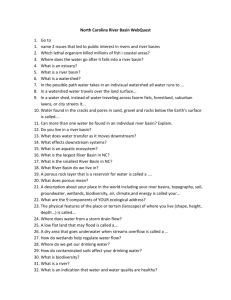
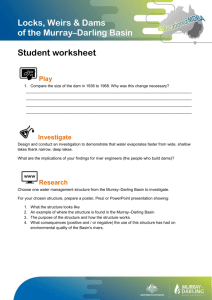
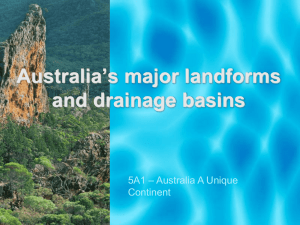
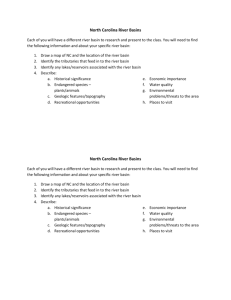
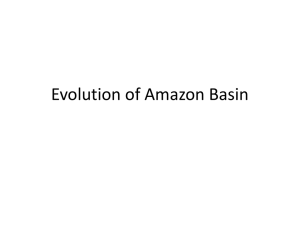
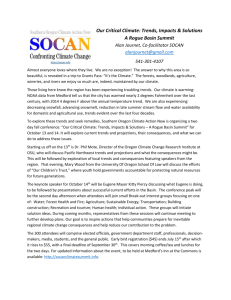
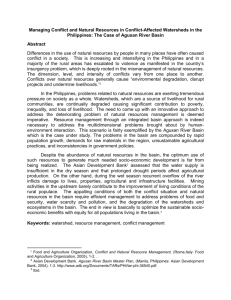
![Georgina Basin Factsheet [DOCX 1.4mb]](http://s3.studylib.net/store/data/006607361_1-8840af865700fceb4b28253415797ba7-300x300.png)